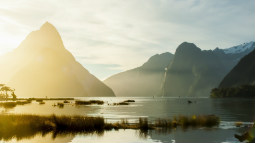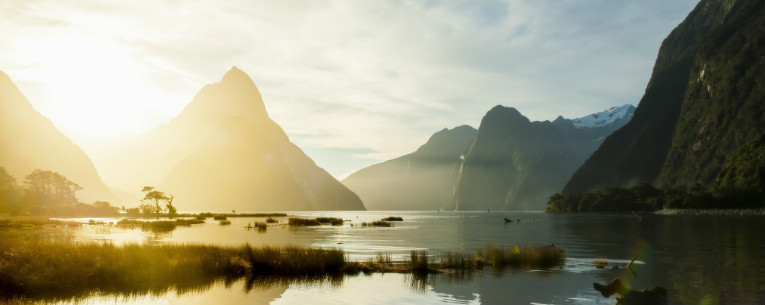Milford Sound, New Zealand
In New Zealand, a nation known for its untouched nature, "tramping" is the national pastime.
Most famous are its Great Walks: nine multi-day trekking adventures that cover some of the most beautiful scenery on the planet, from the Tasman Coast to the forests of Fiordland. But you don’t have to be a backpacker to enjoy hiking New Zealand. These are just a few tramping tracks worth the trip.
The Best Day Hikes in New Zealand
Tongariro Alpine Crossing: While its name makes it sound like an adventure requiring crampons and ice axes, in summertime the Tongariro Alpine Crossing is an achievable, though challenging, day hike. The 19.4 km-track takes you through rugged, volcanic terrain: steam vents, craters, and pools of shimmering blue and green water. In the “Lord of the Rings” movies, Tongariro National Park was the setting for the inhospitable wasteland of Mordor, and Mt. Ngauruhoe — which you can see from the trail — served as Mount Doom.1
Tarawera Trail: Since the 1840s, visitors have flocked to Rotorua, 135 miles southeast of Auckland, to witness the area’s sometimes frightening natural wonders. Here you'll find the unpredictable Pohutu Geyser, which sprays up to 100 feet in the air. One of the best hikes in this part of New Zealand is the Tarawera Trail, a 15-km track that curves around Lake Tarawera to Te Hīnau Bay. A climb to a lookout is rewarded by a soak in steamy springs at Hot Water Beach.
Twilight-Te Werahi Loop: This shorter hike winds through farmland, wetlands and sand dunes on New Zealand’s north coast. In the marshy areas, you may see birds such as gray teals/tētē, New Zealand Shovelers/kuruwhengi, pied stilts/poaka, pied shags and little shags.2 “Combine the hike with a pilgrimage to windswept Cape Reinga (Te Rerenga Wairua), where the swirling waters of the Tasman Sea and the Pacific Ocean meet, and Maori spirits are said to depart for the afterlife,” Lonely Planet suggests.
The Best Backpacking in New Zealand
Milford Track: One of the New Zealand Great Walks, the Milford Track is considered by some to be the finest hike anywhere in the world. The four-day, 53.5-km trek takes you past dramatic fjords and over precarious suspension bridges to see New Zealand’s tallest waterfall, Sutherland Falls. Not only that, but the Milford Track begins with a boat ride from Te Anau Downs. You’ll stay in huts along the way — no tent camping is permitted — so reservations are essential.
The Abel Tasman Coast Track: Open all year, this gentle trek can be completed in three to five days. The trail passes through coastal forests and along golden beaches. On day four, you must time your hike carefully: Awaroa Inlet can only be crossed within a short window around low tide, and after a heavy rain, the inlet may be impassable.3 Highlights include Cleopatra’s Pool, a pool with a natural waterslide, and the chance to see fur seals/kekeno on the beaches.
Grand Traverse: Comprised of the 24-mile Routeburn Track and the 25-mile Greenstone Valley Walk, this six-day walking adventure cuts through Mount Aspiring National Park and Fiordland National Park. The trek is not strenuous and provides stunning views of abundant forests, mountain streams, lakes, and waterfalls. Guided tours are available, and solo hikers must register with local authorities.
Tips for hiking in New Zealand
• Get in shape. Many of New Zealand’s tramping tracks are rugged, with steep elevation changes and rough terrain.
• Make reservations. New Zealand’s famous for its system of cozy huts along hiking trails, which offer low-cost lodging. Don’t just show up and expect to get a bed, however; during the high season (October-April), they fill up fast.
• Prepare for crazy weather. Temperatures can drop (or rise) significantly in the course of a New Zealand hike. Rain gear is always required.
• If you’re hiking in a volcanic area, pay attention. Tongariro National Park is an active volcanic area, and certain parts of the park are considered “volcanic hazard zones.” One particular danger on Ruapehu is lahar: volcanic mudflows that flow swiftly down mountainsides. Pay attention to warning signs and alarms, and know what to do in case of an eruption.
• Don’t contribute to kauri dieback. New Zealand’s native kauri tree is under attack from a microscopic organism that’s spread by soil movement. As a tourist, you need to do your part to help prevent it, which means staying away from kauri roots and thoroughly cleaning your boots and gear after a hike.
• Protect yourself with travel insurance. If you fracture an ankle on the Grand Traverse, getting to the nearest medical facility is going to be challenging — and expensive. Purchase an international travel insurance plan that includes emergency medical transportation and emergency medical benefits.
What Do I Need to Travel to New Zealand?








Share this Page